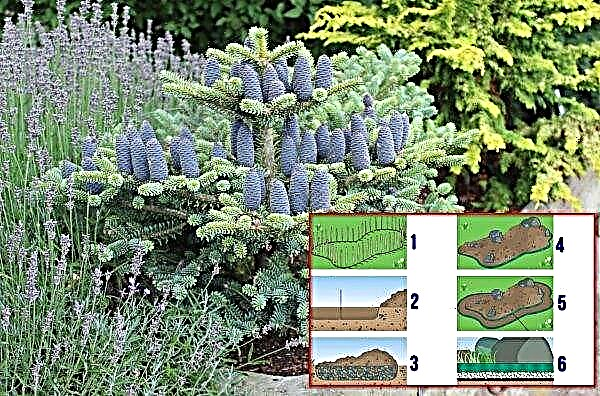A greenhouse without a foundation is an excellent option for farmers who want to save time and materials on the construction. At the same time, gardeners are confused by the strength and possible structural defects. About the rules for constructing a greenhouse without a foundation, and how to fix it, read below.
Design features without foundation
A greenhouse without a foundation is attached to the inner harness with pins attached. This feature helps to avoid the long construction of a full-fledged base. In this case, the structure is tightly held in the soil. This type of greenhouse has its advantages and disadvantages.
Did you know? The Schönbrunn palm greenhouse in Vienna is one of the largest palm greenhouses in the world. More than 4,500 plant specimens grow here, many of which are rare.
Benefits
- A polycarbonate greenhouse without a foundation has many advantages:
- less labor intensive;
- time saving;
- less materials required;
- the design is easy to install on your own;
- the greenhouse is easy to dismantle;
- the building can be easily moved to another section.
Disadvantages
- Gardeners call three main design flaws without a foundation:
- Weeds grow more often as they enter through the soil from the outside.
- The greenhouse protects plants poorly at sudden changes in temperature.
- With a large weight of the coating and insufficient rigidity of the frame, the structure may warp and deform over time.

Seat selection
To place a greenhouse without a foundation, it is necessary to choose a suitable plot.
It must meet the following criteria:
- the minimum amount of clay in the soil - it is better to give preference to sandstones and fertile substrates;
- groundwater not higher than 1.2 m above ground level;
- the area is protected from sudden gusts of wind;
- nearby there are no tall buildings that will obscure the greenhouse;
- distance to the nearest buildings - at least 3 m;
- the distance between the greenhouse and tall trees is from 7 m.
 Rules for choosing a place on the site for the greenhouse.
Rules for choosing a place on the site for the greenhouse.Site preparation for installation
The first step in preparing the site is a geological test. If clay soil is found, it is necessary to dig a pit with a depth and length of sides of 0.7 m. Fill the bottom 0.4 m of the pit with sand. Cover the remaining space with a fertile substrate and lightly tamp.
Immediately before the construction of the greenhouse, do the following:
- Make markings around the perimeter of the future structure, while driving the pegs in the corners.
- Connect the pegs with a cord or rope.
- Level the area and the area 70 cm from the greenhouse perimeter using the level to check.
- Step back 30 cm from the marked perimeter and draw parallel lines that will be the outer edge of the trench.
- Focusing on the greenhouse perimeter and marked external borders, dig a trench 30 cm deep.
- Moderately tamp the bottom of the trench.
Important! Place the greenhouse so that the end walls are turned north and south, and the side walls are west and east. So the plants will receive more lighting.
How to assemble a polycarbonate greenhouse without a base do it yourself
Assembling a greenhouse without a foundation takes place in three stages. First, construct the lower harness. Then fasten the elements of the frame. Lastly, a polycarbonate coating is fixed to the frame profile.
Video: polycarbonate greenhouse assembly
Using a beam for the lower harness
The trench excavated during the preparation of the site is necessary for the construction of the lower harness. For a greenhouse made of cellular polycarbonate, it is advisable to build a lower strapping of timber. For the lower strapping, a beam with a section of 30 × 40 cm is used. The length of the material is determined by the parameters of the greenhouse. When designing, four beams are used: 2 for the end walls and 2 for the side walls.
They are connected with fixing bolts so that in the end the harness rises 10 cm above the level of the trench. Since the greenhouse will not have a foundation, it is mounted on pins. T-shaped pins are attached to the lower harness. Bonded beams with pins in integral form are moved to a trench dug along the perimeter of the structure. So the design will be tightly fixed.
Important! To prevent the destruction of wood under the influence of moisture, the beam must be treated with waterproofing solutions.
Frame assembly
The agricultural market has several varieties of polycarbonate greenhouses - arched, single-pitched, gable, mitlider. It is advisable to assemble the frame according to the instructions for the purchased greenhouse.
Typically, the sequence of actions is as follows:
- Assembly of the end wall frame with doors and windows, as well as reinforcing strips.
- Assembling the frame of the side walls or arched arches, if we are talking about an arched greenhouse.
- Assembling the frame and fixing the roof.
Polycarbonate mount
Polycarbonate is mounted on a frame profile. By this time, the frame should be attached to the lower harness. Polycarbonate sheets are marked according to the drawing and cut into parts. After that, they are attached to the frame with screeds or screws.
Like the assembly of the frame, the fastening of the polycarbonate coating begins with the end walls. Further work continues with the side walls or arch, roof, door and window openings.
Arrangement of a greenhouse inside
A standard greenhouse is divided into two halves for planting. Between these parts trample the path so that it would be convenient for the gardener to care for the plantings. For convenience, the beds are separated from the trail by dividing elements - wooden borders or polycarbonate walls. Beds with different crops, it is advisable to divide the bars.
So there will be no problems with separate top dressing or watering. Professional farmers equip racks in greenhouses. It is convenient to grow seedlings on shelves. They also help when the plant is sick and needs treatment. In this case, it is quarantined and processed separately from healthy plants.
Did you know? In Iceland, greenhouse buildings are equipped near geysers, providing the premises with natural heating.
The disadvantage of a greenhouse without a foundation is poor thermal insulation. To avoid incidents with sudden changes in temperature, some vegetable growers equip the greenhouse with artificial heating. Advanced gardeners also use automatic ventilation and lighting systems. So plant crops develop in the optimal microclimate for them, which is established by the farmer. Weather conditions do not matter.
Greenhouse Care and Maintenance Tips
An important point in the operation of the greenhouse is regular ventilation. Airing is important for the prevention of fungal diseases. If the greenhouse is not equipped with an automatic system, the building can be ventilated by opening the windows and doors. With a competent approach, the result is the same in both cases.
Before starting a new season of work, try to disinfect the soil. If possible, disinfect structural elements - polycarbonate and frame. A solution of potassium permanganate in a concentration of 1% is suitable for treatments. By disinfecting the greenhouse, the gardener prevents the appearance of diseases and pests.
It is not necessary to assemble a greenhouse without a foundation for the winter. For many farmers, designs last 10 years or longer in one place. However, if a lot of snow usually falls in winter, the structure can bend under its weight. In this case, the greenhouse should be kept under control during snowfalls or collected for the winter period. A greenhouse without a foundation has many advantages. One of them is ease of assembly. Due to the simplicity of the design, even an inexperienced farmer can independently assemble and fix the structure. With proper operation, the greenhouse will serve its owner for a long time.
A greenhouse without a foundation has many advantages. One of them is ease of assembly. Due to the simplicity of the design, even an inexperienced farmer can independently assemble and fix the structure. With proper operation, the greenhouse will serve its owner for a long time.












